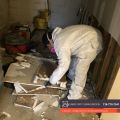Is Mold Inspection and Testing Required Before Remediation?

It is generally recommended to have a mold inspection and testing performed before beginning mold remediation. A mold inspection assesses a home or building to determine any mold growth's presence, location, and extent. A mold inspection may be performed by a professional mold inspection company or a qualified individual, such as an industrial hygienist.

Collecting mold samples from a property and sending them to a lab for analysis is what we mean when we talk about mold testing. Testing for mold can reveal the presence and variety of mold and the amount of contamination.
There are several reasons why it is important to have a mold inspection and testing performed before beginning mold remediation:
To identify the source of the mold:
A mold inspection and testing can help identify the mold growth's cause, such as a leaky roof or high humidity levels. This information addresses the underlying problem and prevents future mold growth.
To verify that the mold has been successfully remediated:
After the mold remediation has been completed, it is important to have a mold inspection and testing performed to confirm that the mold has been successfully removed and that the problem has been resolved.
In short, having a mold inspection and testing before beginning mold remediation is generally recommended to ensure that the problem is properly identified and addressed and to prevent the problem from recurring.
A mold inspection assesses a home or building to determine any mold growth's presence, location, and extent. A mold inspection may be performed by a professional mold inspection company or a qualified individual, such as an industrial hygienist.
How to test Before Remediation
During a mold inspection, the certified mold inspector will look for visible signs of mold and check for moisture sources that could be contributing to mold growth. The inspector may use various tools, such as moisture meters, borescopes (small cameras used to look inside walls), and thermal imaging to identify mold and moisture issues.
After the inspection, the inspector will provide a report detailing the findings and recommend a course of action, such as mold testing or remediation.
Mold testing is collecting mold samples from a home or building and sending the samples to a laboratory for analysis. The mold testing results can help identify the types of mold present and the extent of the mold contamination.
There are several types of mold testing methods, including surface, air, and bulk. Surface testing involves collecting mold samples from surfaces, such as walls or floors, using tape or a swab. Air testing involves collecting samples of mold spores from the air using a special machine called a spore trap or a settling plate. Bulk testing involves collecting a sample of a material, such as insulation or drywall that may be contaminated with mold.
Conclusion
Mold testing can be useful for a variety of reasons. For example, if you suspect that you have a mold problem in your home or building but are not sure where the mold is located, mold testing can help identify the mold locations so that it can be removed. Mold testing can also be helpful if you are trying to determine the extent of a mold problem or if you want to confirm that a mold problem has been successfully remediated.









